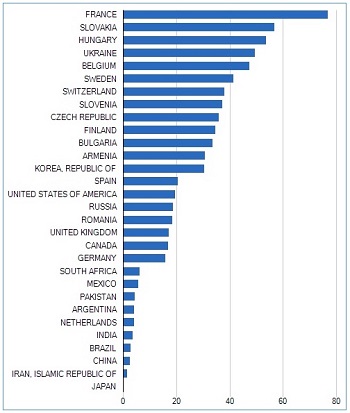WASHINGTON, Sept. 9, 2015 - In the Obama administration’s rush to cut carbon emissions by replacing coal power plants with natural gas plants, wind farms and solar energy, will nuclear power’s reliability and zero-emissions benefits be discarded?
The nuclear industry was pleased that the EPA’s Clean Power Plan rules - finalized in August -allowed states to earn carbon-reduction credits for both new nuclear plants, including plants already under construction, and for increased generation from existing plants. But the final EPA plan scrapped the draft plan’s credit for current output from existing nuclear facilities.
The final plan calls for reducing U.S. electricity plant carbon emissions 32 percent below 2005 levels by 2030, with much of the reduction expected to come from shutting down coal power plants. Along with lower carbon emissions, EPA forecasts that the plan also will reduce toxic power plant emissions 90 percent for sulfur dioxide and 72 percent for nitrogen oxides by 2030.
But a report by the independent think tank Third Way, assisted by MIT researchers and titled “How Nuclear Retirements Might Undermine Clean Power Plan Progress,” sees potential problems and a threat to the role of nuclear power, which currently provides 20 percent of U.S. electricity and 63 percent of America’s zero-emissions electricity. (Hydro provides 20 percent of U.S. clean energy, while wind, solar and geothermal together provide 17 percent.)
The report points out that five reactors have already closed, in part due to badly designed energy markets, and at least nine more are threatened with closure. Challenges include low natural gas prices “compounded by a slowdown in demand due to energy efficiency, the lingering effects of the Great Recession, and state and federal policies that promote new renewable electricity capacity while failing to credit nuclear for producing carbon-free electricity.”
The final Clean Power Plan improves the economics for new nuclear power plants including those under construction now: a Southern Co. plant in Georgia, Scana’s new facility in South Carolina, and the Tennessee Valley Authority’s Watts Bar Unit 2 plant in Tennessee. But there’s a lengthening list of plants threatened with closure. The nine most likely to shut down are industry-leader Exelon’s plants in Ginna, New York, Three Mile Island in Pennsylvania and Byron, Quad Cities and Clinton, Illinois; Entergy’s plants in Pilgrim, Massachusetts, and Indian Point and Fitzpatrick in New York; and FirstEnergy’s Davis-Beese plant in Ohio.
Marvin Fertel, CEO of the Nuclear Energy Institute, charges that the EPA’s final rule “fails to recognize is that CO2 emissions will be significantly higher if existing nuclear power plants shut down prematurely.”
The Third Way report concludes that under current low natural gas prices and EPA rules, closed zero-emissions nuclear plants most likely will be replaced by natural gas plants rather than by wind, solar or other renewable sources. The result would be an increase in power-plant emissions whenever natural gas replaces nuclear power. The report instead favors policy changes to keep more nuclear plants operating by crediting their zero-emissions benefits. It notes that “If wind and solar are to contribute to carbon reductions, far better to have them replace old coal and natural gas plants than our existing fleet of carbon-free nuclear.”
EPA, meanwhile, says it recognizes “the important role nuclear capacity plays in providing reliable, zero‐carbon base load power, and that additional nuclear capacity is under construction in several states.”
However, the agency insists that whether a state opts for rate-based emissions reduction in pounds per megawatt hour or mass-based reduction in total tons of carbon to comply with the Clean Power Plan, “New nuclear plants will be valued assets in states with both mass‐based and rate‐based plans.”
In response to questions from Agri-Pulse, EPA said it is confident that “nuclear power competes well under a mass‐based plan, as increased nuclear generation can mean that fossil fuel units are operating less and emitting fewer tons of CO2.”
EPA adds that “Nuclear, like renewable energy and energy efficiency, can also play an important role in complying with rate‐based emissions guidelines through the creation of ERCs (emission reduction credits) from new nuclear generation.”
Nuclear Share of Electricity Generation 2014

International nuclear share in percent. Source International Atomic Energy Agency
Internationally, there’s widespread recognition of the importance of nuclear energy. The International Atomic Energy Agency (IAEA) Annual Report published last week notes that “With 438 reactors in operation around the world, the total generating capacity of nuclear energy reached 376.2 gigawatts, electrical (GWe) at the end of 2014.” Capacity for the 100 U.S. reactors was 99.3 GWe in 2014. The IAEA said Asia remains the “center of near and long term growth prospects,” accounting for 46 of the 70 reactors under construction worldwide.
The IAEA forecasts “an increase in global nuclear power capacity of 8 percent in the low case and 88 percent in the high case scenario” by 2030 because “interest in nuclear power remains strong in some regions, particularly in countries with fast growing energy needs.”
IAEA Director General Yukiya Amano reported to his board last November that “global energy demand is likely to grow dramatically in the coming decades. At the same time, the world’s carbon footprint must be reduced. Along with hydropower and wind, nuclear energy has the lowest life-cycle CO2 emissions. As part of a low-carbon national energy portfolio, it contributes to the mitigation of climate change and can help to reduce concerns over volatile fuel prices and security of energy supply.”
#30
For more news, go to: www.Agri-Pulse.com
